Abstract
The pathogenicity of classical enteropathogenic Escherichia coli strains of human origin was investigated in gnotobiotic piglets. One to two day old piglets in groups of four were infected perorally with approximately 10(8) colony forming units of one of eight enteropathogenic E coli strains or a non-pathogenic control strain. Animals were necropsied 24 or 48 hours after infection and their intestines were subjected to histological examination, quantitative bacterial culture and estimation of lactase activity. Four enteropathogenic E coli strains caused mild to moderate diarrhoea in nine of the 16 piglets inoculated with them. Piglets given two of these strains later became moribund. One enteropathogenic E coli strain caused a severe illness unaccompanied by diarrhoea. Inflammation of the intestinal mucosa occurred with all eight enteropathogenic E coli strains, but not with the control strain. Pathological changes were most pronounced in the distal ileum and colon and adherent bacteria were seen on the surface of the inflamed mucosa. The extent of the inflammatory response in infected piglets for the most part paralleled the severity of the clinical signs, the degree of bacterial colonisation and the reduction in lactase activity. Electron microscopic examination of tissue from piglets infected with three different strains showed that bacterial adherence to the apical plasma membrane of epithelial cells was accompanied by distinctive ultrastructural changes. These included degeneration of the microvillous brush border, together with cupping and pedestal formation of the plasma membrane at sites of bacterial attachment. The same changes have been seen in naturally occurring enteropathogenic E coli diarrhoea in humans and rabbits. The combined clinical and pathological findings indicate that the neonatal gnotobiotic piglet is a suitable model of infection with enteropathogenic E coli.
Full text
PDF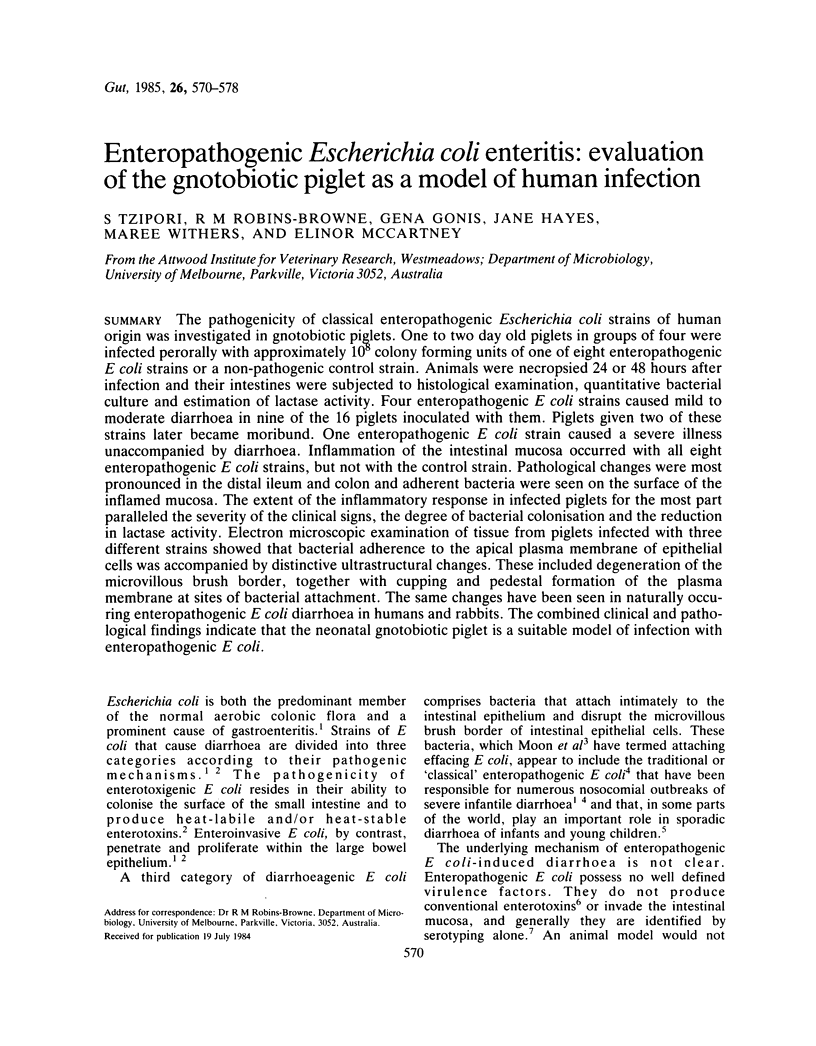
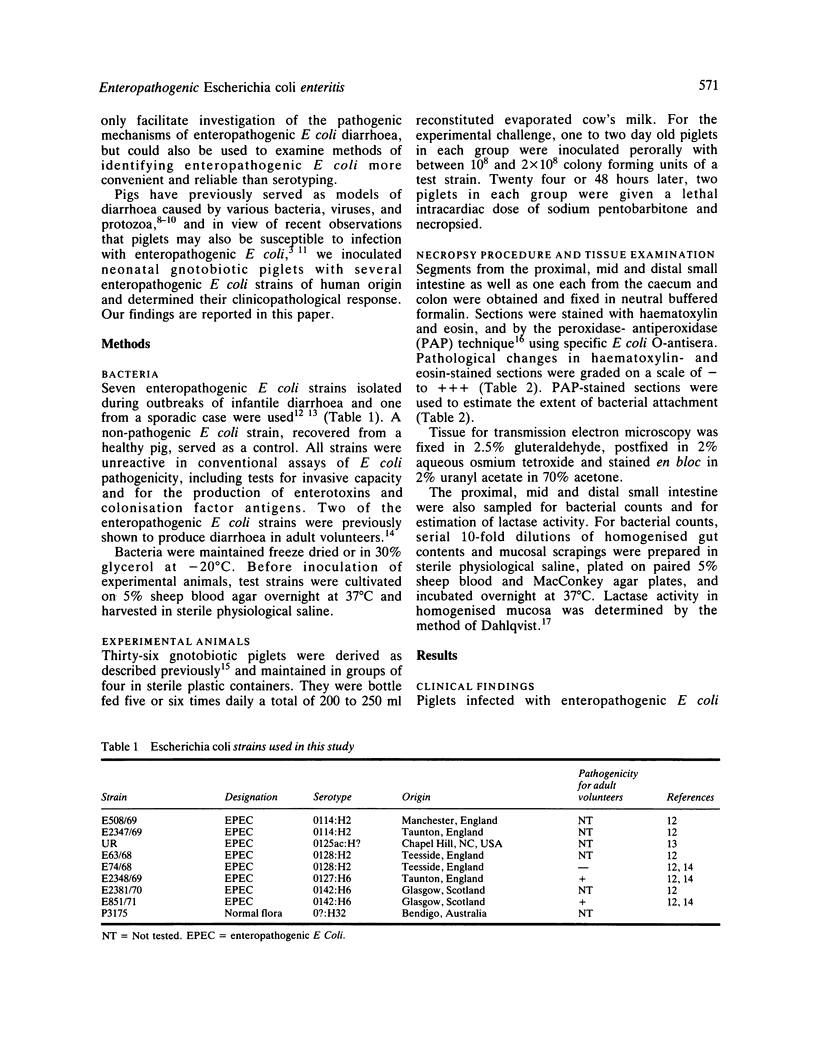
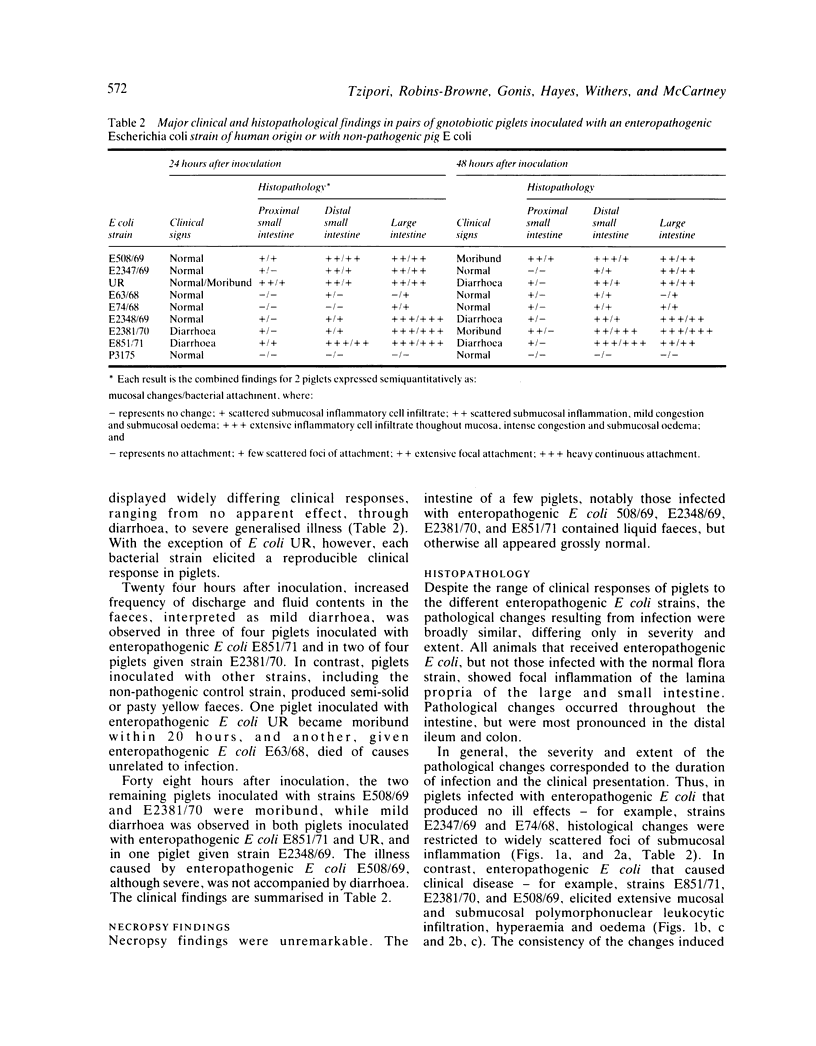
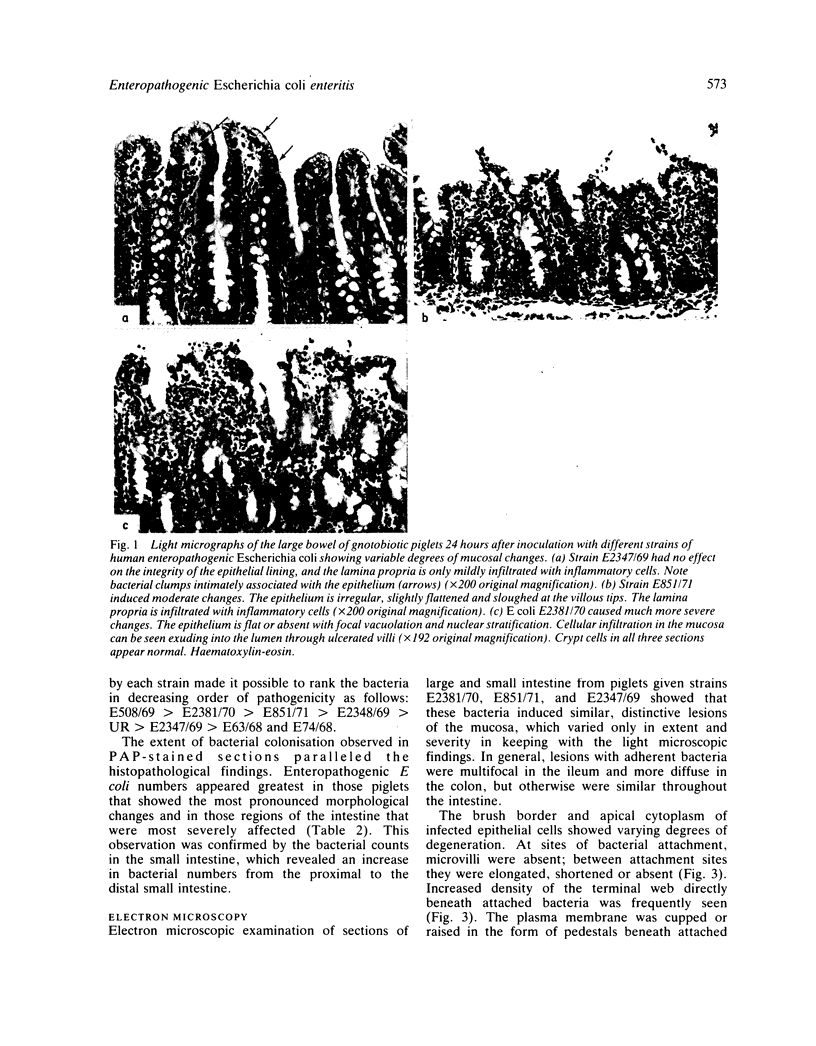
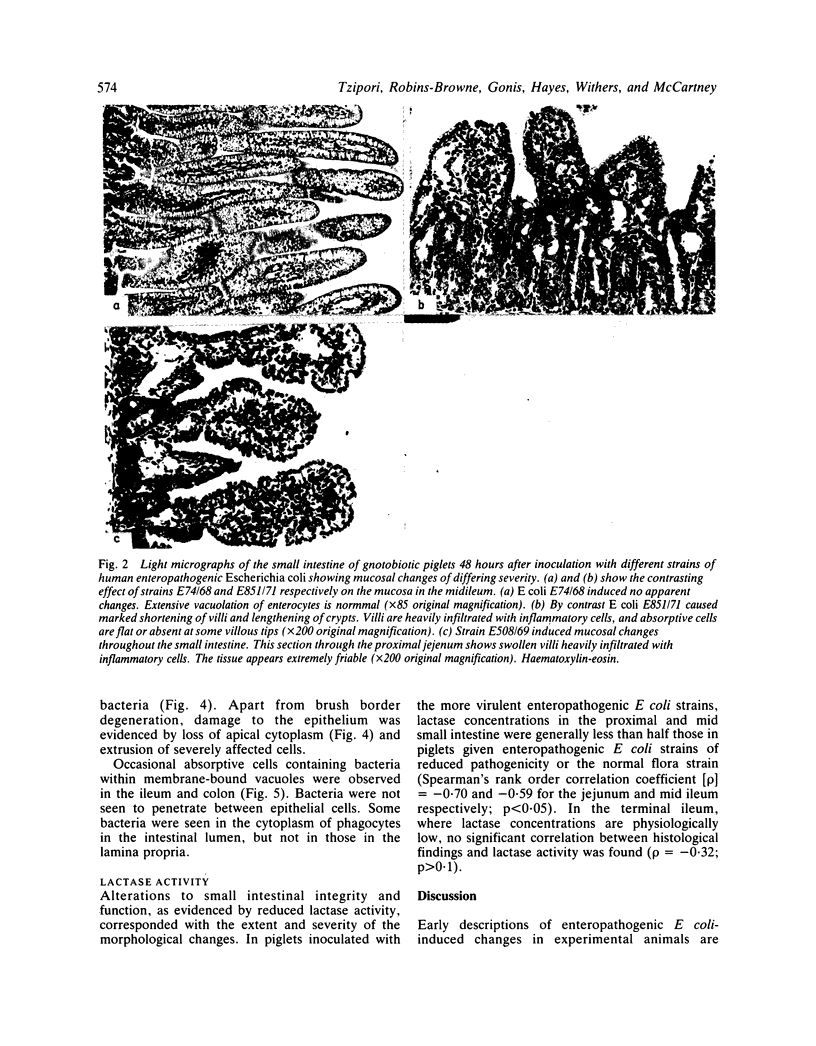
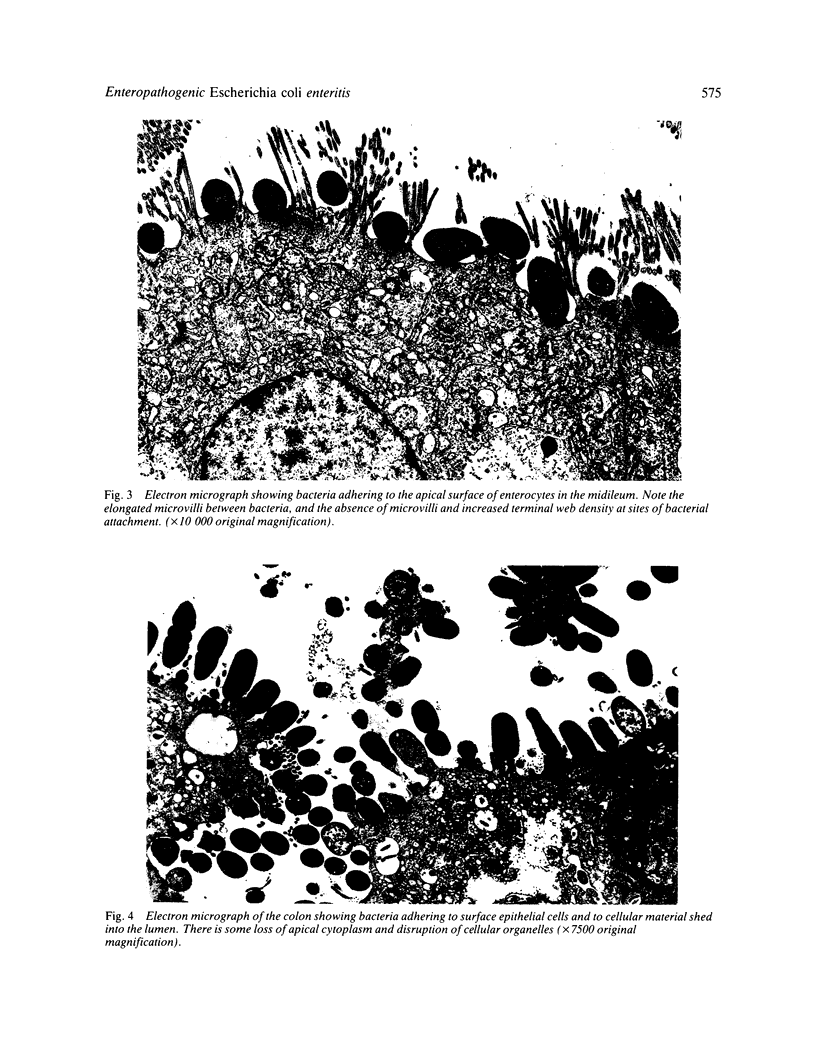
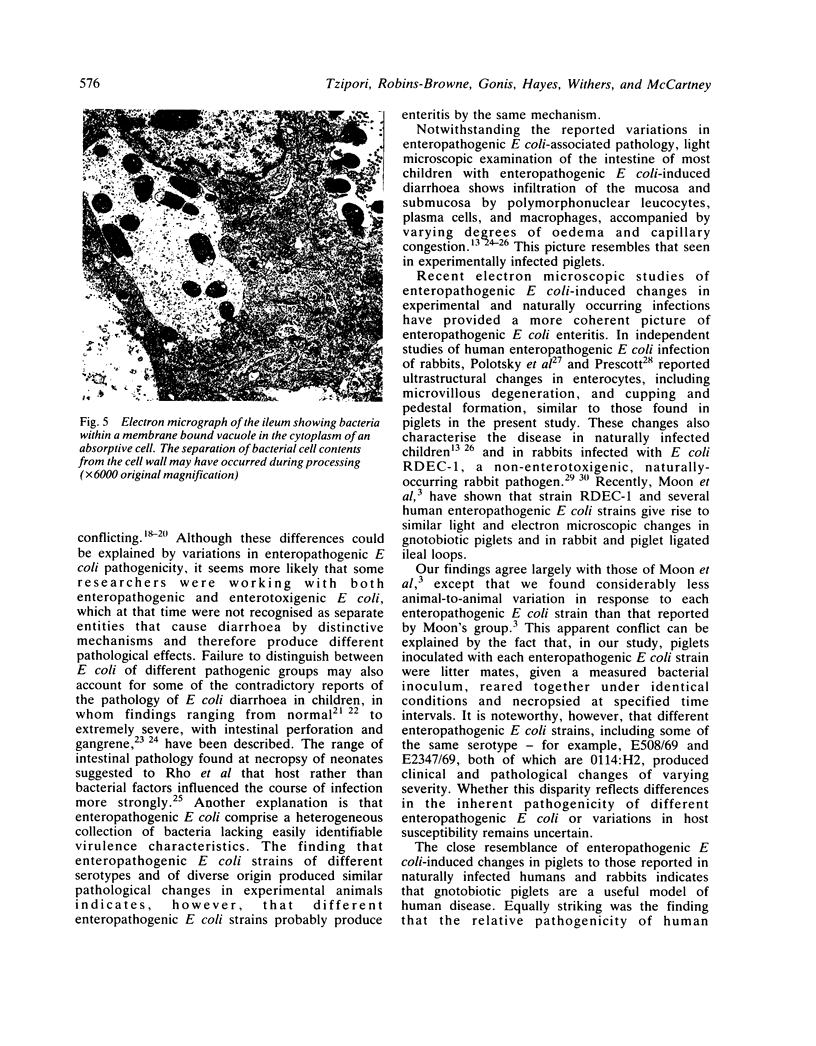
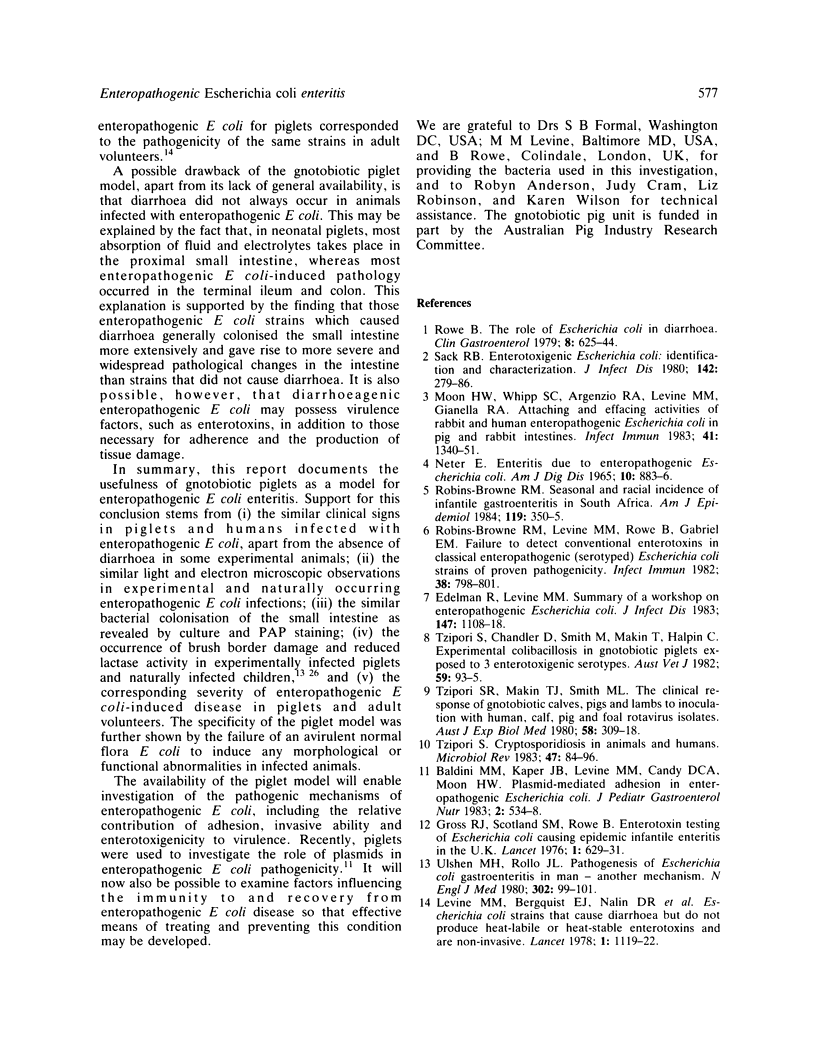
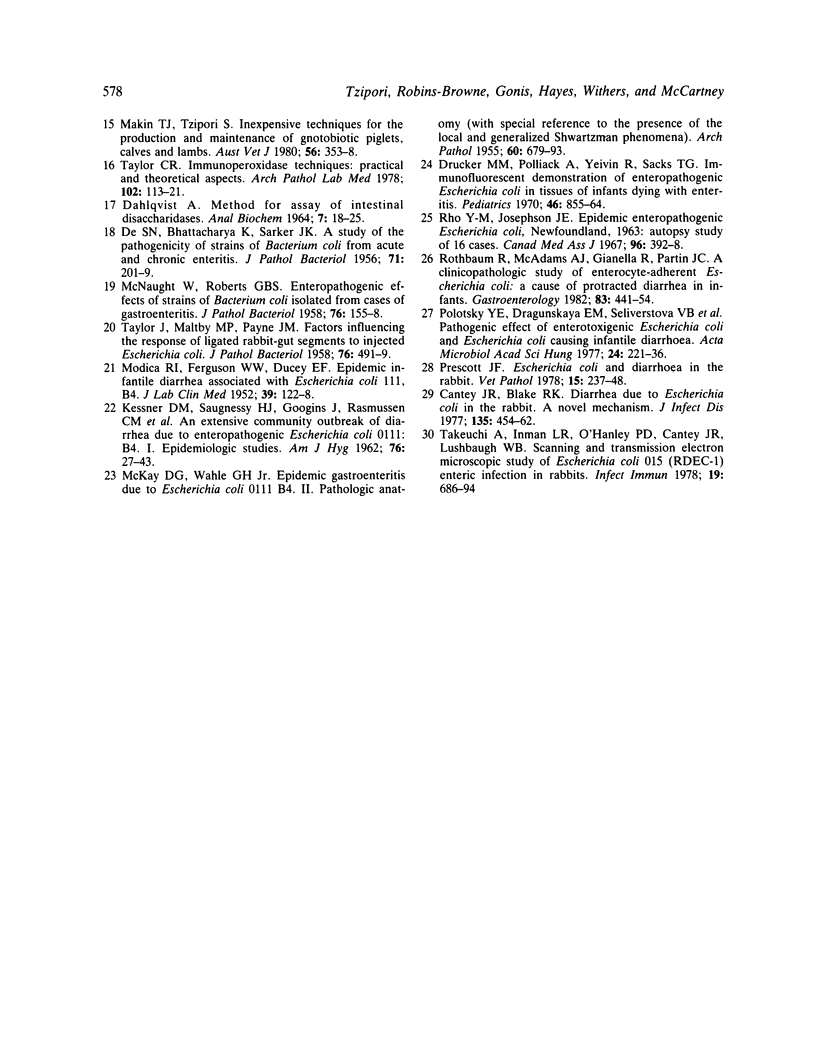
Images in this article
Selected References
These references are in PubMed. This may not be the complete list of references from this article.
- Baldini M. M., Kaper J. B., Levine M. M., Candy D. C., Moon H. W. Plasmid-mediated adhesion in enteropathogenic Escherichia coli. J Pediatr Gastroenterol Nutr. 1983;2(3):534–538. doi: 10.1097/00005176-198302030-00023. [DOI] [PubMed] [Google Scholar]
- Cantey J. R., Blake R. K. Diarrhea due to Escherichia coli in the rabbit: a novel mechanism. J Infect Dis. 1977 Mar;135(3):454–462. doi: 10.1093/infdis/135.3.454. [DOI] [PubMed] [Google Scholar]
- DAHLQVIST A. METHOD FOR ASSAY OF INTESTINAL DISACCHARIDASES. Anal Biochem. 1964 Jan;7:18–25. doi: 10.1016/0003-2697(64)90115-0. [DOI] [PubMed] [Google Scholar]
- DE S. N., BHATTACHARYA K., SARKAR J. K. A study of the pathogenicity of strains of Bacterium coli from acute and chronic enteritis. J Pathol Bacteriol. 1956 Jan;71(1):201–209. doi: 10.1002/path.1700710126. [DOI] [PubMed] [Google Scholar]
- Drucker M. M., Polliack A., Yeivin R., Sacks T. G. Immunofluorescent demonstration of enteropathogenic Escherichia coli in tissues of infants dying with enteritis. Pediatrics. 1970 Dec;46(6):855–864. [PubMed] [Google Scholar]
- Edelman R., Levine M. M. From the National Institute of Allergy and Infectious Diseases. Summary of a workshop on enteropathogenic Escherichia coli. J Infect Dis. 1983 Jun;147(6):1108–1118. doi: 10.1093/infdis/147.6.1108. [DOI] [PubMed] [Google Scholar]
- Gross R. J., Scotland S. M., Rowe B. Enterotoxin testing of Escherichia coli causing epidemic infantile enteritis in the U.K. Lancet. 1976 Mar 20;1(7960):629–631. doi: 10.1016/s0140-6736(76)90429-3. [DOI] [PubMed] [Google Scholar]
- KESSNER D. M., SHAUGHNESSY H. J., GOOGINS J., RASMUSSEN C. M., ROSE N. J., MARSHALL A. L., Jr, ANDELMAN S. L., HALL J. B., ROSENBLOOM P. J. An extensive community outbreak of diarrhea due to enteropathogenic Escherichia coli 0111:B4. I. Epidemiologic studies. Am J Hyg. 1962 Jul;76:27–43. doi: 10.1093/oxfordjournals.aje.a120262. [DOI] [PubMed] [Google Scholar]
- Levine M. M., Bergquist E. J., Nalin D. R., Waterman D. H., Hornick R. B., Young C. R., Sotman S. Escherichia coli strains that cause diarrhoea but do not produce heat-labile or heat-stable enterotoxins and are non-invasive. Lancet. 1978 May 27;1(8074):1119–1122. doi: 10.1016/s0140-6736(78)90299-4. [DOI] [PubMed] [Google Scholar]
- MCKAY D. G., WAHLE G. H., Jr Epidemic gastroenteritis due to Escherichia coli O111 B4. II. Pathologic anatomy, with special reference of the presence of the local and generalized Shwartzman phenomena. AMA Arch Pathol. 1955 Dec;60(6):679–693. [PubMed] [Google Scholar]
- MODICA R. I., FERGUSON W. W., DUCEY E. F. Epidemic infantile diarrhea associated with escherichia coli 111, B4. J Lab Clin Med. 1952 Jan;39(1):122–128. [PubMed] [Google Scholar]
- Makin T. J., Tzipori S. Inexpensive techniques for the production and maintenance of gnotobiotic piglets, calves and lambs. Aust Vet J. 1980 Aug;56(8):353–358. doi: 10.1111/j.1751-0813.1980.tb09558.x. [DOI] [PubMed] [Google Scholar]
- McNAUGHT W., ROBERTS G. B. Enteropathogenic effects of strains of Bacterium coli isolated from cases of gastro-enteritis. J Pathol Bacteriol. 1958 Jul;76(1):155–158. doi: 10.1002/path.1700760117. [DOI] [PubMed] [Google Scholar]
- Moon H. W., Whipp S. C., Argenzio R. A., Levine M. M., Giannella R. A. Attaching and effacing activities of rabbit and human enteropathogenic Escherichia coli in pig and rabbit intestines. Infect Immun. 1983 Sep;41(3):1340–1351. doi: 10.1128/iai.41.3.1340-1351.1983. [DOI] [PMC free article] [PubMed] [Google Scholar]
- Neter E. Enteritis due to enteropathogenic Escherichia coli. Am J Dig Dis. 1965 Oct;10(10):883–886. doi: 10.1007/BF02236098. [DOI] [PubMed] [Google Scholar]
- Polotsky Y. E., Dragunskaya E. M., Seliverstova V. G., Avdeeva T. A., Chakhutinskaya M. G., Kétyi I., Vertényl A., Ralovich B., Emödy L., Málovics I. Pathogenic effect of enterotoxigenic Escherichia coli and Escherichia coli causing infantile diarrhoea. Acta Microbiol Acad Sci Hung. 1977;24(3):221–236. [PubMed] [Google Scholar]
- Prescott J. F. Escherichia coli and diarrhoea in the rabbit. Vet Pathol. 1978 Mar;15(2):237–248. doi: 10.1177/030098587801500210. [DOI] [PubMed] [Google Scholar]
- Rho Y. M., Josephson J. E. Epidemic enteropathogenic Escherichia coli, Newfoundland, 1963: autopsy study of 16 cases. Can Med Assoc J. 1967 Feb 18;96(7):392–398. [PMC free article] [PubMed] [Google Scholar]
- Robins-Browne R. M., Levine M. M., Rowe B., Gabriel E. M. Failure to detect conventional enterotoxins in classical enteropathogenic (serotyped) Escherichia coli strains of proven pathogenicity. Infect Immun. 1982 Nov;38(2):798–801. doi: 10.1128/iai.38.2.798-801.1982. [DOI] [PMC free article] [PubMed] [Google Scholar]
- Robins-Browne R. M. Seasonal and racial incidence of infantile gastroenteritis in South Africa. Am J Epidemiol. 1984 Mar;119(3):350–355. doi: 10.1093/oxfordjournals.aje.a113753. [DOI] [PubMed] [Google Scholar]
- Rothbaum R., McAdams A. J., Giannella R., Partin J. C. A clinicopathologic study of enterocyte-adherent Escherichia coli: a cause of protracted diarrhea in infants. Gastroenterology. 1982 Aug;83(2):441–454. [PubMed] [Google Scholar]
- Rowe B. The role of Escherichia coli in gastroenteritis. Clin Gastroenterol. 1979 Sep;8(3):625–644. [PubMed] [Google Scholar]
- Sack R. B. Enterotoxigenic Escherichia coli: identification and characterization. J Infect Dis. 1980 Aug;142(2):279–286. doi: 10.1093/infdis/142.2.279. [DOI] [PubMed] [Google Scholar]
- TAYLOR J., MALTBY M. P., PAYNE J. M. Factors influencing the response of ligated rabbit-gut segments to injected Escherichia coli. J Pathol Bacteriol. 1958 Oct;76(2):491–499. doi: 10.1002/path.1700760218. [DOI] [PubMed] [Google Scholar]
- Takeuchi A., Inman L. R., O'Hanley P. D., Cantey J. R., Lushbaugh W. B. Scanning and transmission electron microscopic study of Escherichia coli O15 (RDEC-1) enteric infection in rabbits. Infect Immun. 1978 Feb;19(2):686–694. doi: 10.1128/iai.19.2.686-694.1978. [DOI] [PMC free article] [PubMed] [Google Scholar]
- Taylor C. R. Immunoperoxidase techniques: practical and theoretical aspects. Arch Pathol Lab Med. 1978 Mar;102(3):113–121. [PubMed] [Google Scholar]
- Tzipori S. R., Makin T. J., Smith M. L. The clinical response of gnotobiotic calves, pigs and lambs to inoculation with human, calf, pig and foal rotavirus isolates. Aust J Exp Biol Med Sci. 1980 Jun;58(3):309–318. doi: 10.1038/icb.1980.31. [DOI] [PubMed] [Google Scholar]
- Tzipori S., Chandler D., Smith M., Makin T., Halpin C. Experimental colibacillosis in gnotobiotic piglets exposed to 3 enterotoxigenic serotypes. Aust Vet J. 1982 Sep;59(3):93–95. doi: 10.1111/j.1751-0813.1982.tb02736.x. [DOI] [PMC free article] [PubMed] [Google Scholar]
- Tzipori S. Cryptosporidiosis in animals and humans. Microbiol Rev. 1983 Mar;47(1):84–96. doi: 10.1128/mr.47.1.84-96.1983. [DOI] [PMC free article] [PubMed] [Google Scholar]
- Ulshen M. H., Rollo J. L. Pathogenesis of escherichia coli gastroenteritis in man--another mechanism. N Engl J Med. 1980 Jan 10;302(2):99–101. doi: 10.1056/NEJM198001103020207. [DOI] [PubMed] [Google Scholar]







